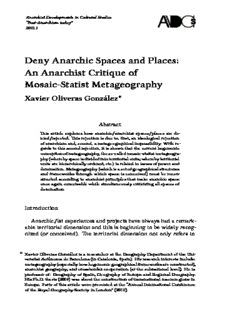
Deny Anarchic Spaces and Places: An Anarchist Critique of Mosaic-Statist Metageography PDF
Preview Deny Anarchic Spaces and Places: An Anarchist Critique of Mosaic-Statist Metageography
181 181 AnarchistDevelopmentsinCulturalStudies “Post-Anarchismtoday” 2010.1 Deny Anarchic Spaces and Places: An Anarchist Critique of Mosaic-Statist Metageography ∗ Xavier Oliveras González Abstract Thisarticleexploreshowanarchic/anarchistspaces/placesarede- nied/rejected.Thisrejectionisdueto,first,anideologicalrejection ofanarchismand,second,ametageographicalimpossibility.Withre- gardstothissecondrejection,itisshownthatthecurrenthegemonic conceptionofmetageography,theso-calledmosaic-statistmetageogra- phy(wherebyspaceisdividedintoterritorialunits;wherebyterritorial unitsarehierarchicallyordered;etc.)isrelatedtoissuesofpowerand domination.Metageography(whichisasetofgeographicalstructures andframeworksthroughwhichspaceisconceived)mustberecon- structedaccordingtoanarchistprinciplesthatmakeanarchicspace onceagainconceivablewhilesimultaneouslycriticizingallspacesof domination. Introduction Anarchic/istexperiencesandprojectshavealwayshadaremark- ableterritorialdimensionandthisisbeginningtobewidelyrecog- nized (or conceived). The territorial dimension not only refers to ∗ XavierOliverasGonzálezisaresearcherattheGeographyDepartmentoftheUni- versitatAutònomadeBarcelona(inCatalonia,Spain).Hisresearchinterestsinclude: metageography(especiallyhowhegemonicgeographicalframeworksareconstructed), anarchistgeography,andcrossbordercooperation(atthesubnationallevel). Heis professorof: GeographyofSpain,GeographyofEuropeandRegionalGeography. HisPh.D.thesis(2009)wasabouttheconstructionoftransnationalmacroregionsin Europe.Partsofthisarticlewerepresentedatthe“AnnualInternationalConference oftheRoyalGeographySocietyinLondon”(2010). 181 181 182 182 182 XavierOliverasGonzález geographicallocalizationbutalsotothecapacityandpotentialtocon- struct“spaces”and“places”,outsideofdominionrelationsspace(like statistspace),basedonegalitarianandanti-authoritarianrelations, non-hierarchical social practices, collective and individual auton- omy,cooperativestructures,etc. Soanarchic/istspacesandplaces canbedefinedasthe(constructed)territoriesbasedonanddueto anarchistprinciplesandpeoples,muchlikestatelesspeoplesspaces, libertariancommunities, socialcentres, municipioslibres, Spanish Revolutioncollectivizations,TemporaryAutonomousZones(TAZs), situationsconstruites,parties,revolts,etc.,everywhereandanytime. Thesearethe“anarcho-territories”asAnarco-Territoris(ajournalof anarchistterritorialthought)hasnamedthem. Inthissense,anar- chyandanarchismhaveabroadervisionthanthemoretraditional, commonandrestrictedsense,proposedbysomeanarchistscholars (Shukaitis,2009;Rebolloetal.,2009). For many people (perhaps excluding anarchists) anarchic/ist spacesandplacesdonotfitwithinthecurrenthegemonicgeographi- calstructuresandframeworks(inaWorldorderedbyStatesandcap- italism),thatwecallthemosaic-statistmetageography. Asaresult, anarchic/istspacesandplacesarenotunderstood,muchlesscon- ceived. Themosaic-statistmetageography(producedandimposedby Statesandtheirapparatusesandalliesincludinggovernment,school, massmedia,etc.) hashinderedtheconceptionandvisualizationof anarchicplacessinceXIXth. Buttodayanewmetageographyisin development. Despitetheideologiesofgeographicalframeworks(usedevery- dayfromthemostcommonconversationstopoliticalandscientific speechesandconcepts),metageographyhasbeenpaidlittleatten- tionfromwithinthedistinctiveanarchistperspective. Nevertheless someanarchistsareconcernedwiththisquestion. TheTurkishpost- anarchistsEvren&Öğdül(2002)andEvren(2006)havearguedthat thereisarelationshipbetweenmosaic-statistmetageography,euro- centrism,capitalismandglobalization. Metageography: MakingSpaceConceivable Beforecharacterizingthemosaic-statistmetageographyitisnec- essary to define the very concept of “metageography”. There are veryfewdifferentmeaningsinacademicliterature. HereIadoptthe definitionprovidedbyLewis&Wigen(1997)andTaylor(2003),and 182 182 183 183 DenyAnarchicSpacesandPlaces 183 Raffestin(1978,1983). Metageographydescribestheinternallycon- sistentsetofspatialstructuresorconceptualframeworksthrough whichindividualsandgroupsconceive,order,andinterpretspace and/orthespatialdimensionoftheworld,thecosmosand/orthe universe. Someexamplesofspatialstructuresorframeworksinclude thefollowingconcepts: “region,”“country,”“continent,”“culture,”“cli- mate”or“eco-region”;thedualisticdivisionbetweenruralandurban spaces;thecardinalpoints(North,South,WestandEast). Itisim- portant to think these concepts through with all of the ideas and valuesthatareoftenassociatedwiththembecausetheysetpolitical priorities which concern real and imaginary space. In this sense, Toldrà (2010) has explained how Catholic Heaven and Hell were constructedintheMiddleAges: bothofthemwereaperfectcopy offeudalterritorialandsocialorganization. Historically,thefirstmetageographiesweredevelopedatthepre- cisemomentthatHumansbecameconsciousoftheworldaround them and of themselves as beings within it. This was when the worldbecameconceptualizedandcommunicatedthroughanykind oflanguage(asetandsystemofsignsandsymbols). Conceptssuch as“space,”“world,”or“universe,”amongothers,havebeennothing morethanmetageographicalframeworksthroughwhichspaceasa realobjecthasbeenconceived. Forinstance,intheModernEuro- peanworldview“space”isunderstoodasanunlimited,continuous andthree-dimensionalenvironmentthatcontainsphysicalobjects. Metageographyallowsustothinkandtalkaboutspaceandspatial relationshipsand,inturn,itallowsustoproduceadvancementsin geographicalknowledge. Howeverthispossibilityislimited. Meta- geographyalsofixestheconceptualandmentallimitsinwhichthe worldandthetermsthroughwhichtothinkaboutitarepossible. It “tellsus”whatspatialprocessesorelementswemustobserve,aswell asthewayinwhichtheseprocessesandelementsmustbeobserved andordered. Inshort,metageographicalstructuresimposeaninand anoutwhichitmakespossiblewithinestablishedtermsanddisables anythingwhichgoesbeyonditslimits. Inotherwords,itdisables otherpossiblemetageographies. In another sense metageography is both (a) an instrument (or a means) through which to develop goals and actions, and (b) an environmentinwhichtodevelopthem. 183 183 184 184 184 XavierOliverasGonzález 1. Metagragraphy(Instrument): Functions Asaninstrument,thebasicmetageographicalfunctionistocon- ceiveofthespaceandthespatialrelationshipsthatexistbetween humansandotherelementscontainedinspace. Fromthispointof viewotherspecificfunctionscanbedefined: • Toorientspace: toplacereferencepoints,cardinalpoints,etc. • Tounderstandspace: toexplainspatialphenomenaandelements (particularly physical, meteorological, seismic, forms of relief, vegetation,etc);topredictspatialphenomena. • Toorderspace: toclassifyandstructurehierarchicalspacesand places. • Tointerpretspace: toprovideethical,economic,symbolic,etc., valuestospaceand/ortoitselements. • To communicate in and about space: to give place names (to- ponyms). • Toidentify: toassociateidentitieswithplaces. • Tomeasurespace: tocountspaceandspatialelements. • Todominateandcontrolspace: tomanagespace(humanand physicalelements),toexploititsresources. 2. Metageography(Environment): Components Asanenvironment,ametageographyhasthreecomponents: • Pattern: corresponds to the territorial model through which space and spatial relationships (between actors and spatial el- 184 184 185 185 DenyAnarchicSpacesandPlaces 185 ements)areordered. Tomakeanarchitecturalsimile,patternis likeabuilding. • Content: corresponds to the characteristics that define space, eventsandspatialelementsandactors. Tomakeanarchitectural simile,contentiswhatisputinsideabuilding. • Meaning:correspondstotheinterests,ethical,aesthetic,emotion values,prejudices,etc.,thatareloadedintopatternandcontent components(orintothebuildinganditscontent). MetageographyandPower&Dominion: TheMosaic-Statist Metageography Thereisanimportantrelationshipbetweenmetageographyand power(&dominion),asisdemonstratedbymetageographicalfunc- tions(metageographyasaninstrument). Ametageographyisnever neutral,especiallyinasocio-spatialcontextofdominionrelations. Firstofall,itisasocialconstruction(notnatural)developedbya particularsocialgroup. Thisgroupissocially,ideologicallyandgeo- graphicallylocatedandimposesitsconceptionsonotherindividuals andcollectives. Asaconsequence,itsproductionandreproduction reflectstheinterestsandmeaningsofthatspecificterritorialactor. Paraphrasing George Orwell’s “He who controls the past con- trolsthefuture”(1984),itcanbesaidthatthegroupwhocontrols metageography(anditsconstruction)controlstheterritory(witha hegemonicdesireandwithimposedterms)(Figure1). Thisisthe caseformetageographiesconstructedbygroupsthatholddominion ofanykind(includingpolitical,economical,andreligious,among others). Thesevariousconstructionstendtoconvergeintoasingle internallyconsistentmetageographywhilelegitimizingthepower relationshipsestablishedbyassociatedgroups. Groupsaregranted theappearanceofnaturalness,inevitability,ahistoricity,and/orsci- entism. Themajorityofpre-modernsocieties(priortothefifteenthcen- tury)havebuiltstates(suchasAztec,Inca,Egyptian,Chinese,Greek, Roman,etc.),inthisrespecttheyhavedevelopedsimilarmetageo- graphicalstructures. Despitethecultural,socialorenvironmental differences,allofthesesocietieshaveincommontheirsedentariness 185 185 186 186 186 XavierOliverasGonzález Control Metageography relationsofpower&dominion Space Figure1 TheRelationshipbetweenControlandMetageography Source:OwnElaboration (based on agriculture and urban development) and a clear hierar- chicalsocialdivision. TheNeolithicandUrbanrevolutionshadan enormousimpactonmetageographicalconstruction. Infact,their metageographycoveredallfunctionsfromspatialorientationtothe dominion,controlandexploitationoftheirterritoryandthespaces beyond. Similarly,almosteverysuchsocietyhashada“tendency [...]tosituatethemselvesatthecentreoftheirworlds,toexaggerate theextentoftheirterritorialcontrol,andatthesametimetoenvis- ageoneormorezonesbeyond”(RaaflaubandTalbert,2010: 4). The metageographicalsimilaritiesallrevolveespeciallyaroundthepat- terncomponent,andcanbeclassifiedasa“mosaicmetageography”: ethnocentrism(creatingan“us”locatedinthecentreoftheworld anda“them”intheperiphery)andpolygonism(creatingterritorial unitsdelimited,defined,andhierarchicallyordered). Althoughthecurrentmosaicmetageographyishegemonicinmod- ernEuropeansociety(inheritedfromGreek,RomanandChristian metageographicalstructures),therearesomedifferences(inthecon- tentandmeaning)(LewisandWigen,1997). Recently,ithasbeen exportedandimposedgloballythroughcolonialism,imperialismand globalization(EvrenandÖğdül,2002). Thistypeofmetageography changedsignificantlysincethesixteenthcenturyandhasbeenespe- ciallyintenseinthenineteenthcentury(thatis,duringtheModern world-systemasImmanuelWallersteincalledit): ithasbeencom- binedwithstatistandcapitalistideology,givingrisetowhatcanbe calledthe“mosaic-statistmetageography”(Taylor,2003). Thisisthe hegemonicmetageographicalstructureintheEuropeanizedworld today. Withinthepolygonalcomponent,mosaic-statistmetageography ordersgeographicalspacethroughparcels,asifitwereamosaicora 186 186 187 187 DenyAnarchicSpacesandPlaces 187 puzzlewhereeverypieceisanindependententitycontinuoustothe others. Overlappingspaces,spaceswithoutdescription,voidspaces orintermediatespacesareaberrations. Statistideologyconceivesthe“state”astheonlysovereignentity overadelimitedterritory. Theresultistheriseoffractionaldivisions oftheworldintoclearlydemarcatedandcontiguouspieces,suchas states,regions,languages,cultures,ecosystems,etc. Everypieceis endowedwithuniquecharacteristics. Themosaic-statistmetageog- raphyhasalsobeencombinedwithotherideassuchaseurocentrism andEuropeanuniversalism(i.e.,puttingEurope,Europeansociety, anditsvaluesatthecentreandonahigherhierarchicalposition), economismandcapitalism(i.e.,toassignprimaryimportancetoeco- nomicrelationsandthedominionofcapitalisteconomy),scientism (i.e.,thedominionofphysicalandbiologicalsciencesinthedevelop- mentofspatialmetaphors),ortheideaofhistoricalprogression(i.e., linearandrisingevolutionofHistory). Asaresultofthevarious combinations,mosaic-statistmetageographycanbecharacterized asfollows: a. Spaceisorderedasamosaic(orapuzzle),whereeverypieceis anindependententitycontinuoustoothers. b. Territorialdelimitationisessential. c. Any place must be assigned to one territorial unit; therefore, emptyspaces(ofstatepower,capital,etc),multipleassignments, overlapsandcrosscutsmustberemoved. Everythingmustbe mapped,namedandcontrolled. d. Thereisaterritorialsovereigntywithinanarea,aswellasamain characteristic,homogeneityoressence(likeaStateistheonly sovereignentityoveraterritory). e. Territorialunitsandphenomenaarehierarchicallyordered,ac- cordingtotheconcentrationofpowerandvaluesassociatedwith everyone. f. Alloftheaboveconsiderationsandtheirconsequencesareas- sumedandsupposedtobenormalornaturaland,therefore,in- evitable(whethercreatedbyGodsorNature,andreligiouslyor scientificallydemonstrable). 187 187 188 188 188 XavierOliverasGonzález Finally,theproductionandreproductionofthatmetageography isaccompaniedbytwomoreprocesses(infact,thesearecommonin othermetageographicalconstructions): namingandgraphicallyrep- resentingthespace. Throughtheseactionsspaceisprovidedwith names (toponyms and taxons) and images (maps). Both are sym- bols. Visionandverbalizationhaveapreponderantrole(aboveother senses and forms of expression) in mosaic-statist metageography, unlikeotherpossiblemetageographies. Theirdominanceisbasedon thepresumptionofanobjectivityinwhichonebelievesoneselfto beabletoviewandword. Inthissensecartographyandlanguage (the set formed with maps, place names, scales, orientations and projections)actasamechanismandmetaphor: tonameanddrawa spaceistoconvertnothingintoametageographicalstructure. The paradigmaticexampleisundoubtedlythepoliticalmapofthestates (andtheirsubdivisions). DenyingAnarchic/istSpaceandPlaces Thegeographicalimaginaryproducedbymosaic-statistmetageog- raphyrendersotherspatialrealitiesunimaginable. Forexample,in officialhistorytheHanseaticLeagueortheMalaymaritimeempire arenotconsideredasStates,sinceitsstatespacewasanetworkof portsandcities(betweenwhichthereweretheseaandotherterri- tories)(Scott,2009). Thesemetageographiesfaceametahistorical impossibility: the idea of historical progression can enable us to conceive pre-modern states as “states”. In a similar sense, Pierre Clastres(1974)showedhowstatelesssocietieswereimpossibleto conceiveintraditionalWesternanthropology: “society”wasalways associatedwithdominionpowerrelations. Epistemologically,the obstaclefacedwasduetoaWesternculturalethnocentrismandan exoticviewofnon-Westernsocieties. Anarchic/istterritorialityisneglected,negated,despised,underes- timated,orreduced. Everyanarchistcouldsayasmuchfromher/his ownexperience: theobjectionsagainstanarchyareproducedand reproduced in cultural texts and by everyday people. The meta- geographicalpositioningtowardanarchicspacesisillustratedvery clearlybyDavidGraeber(2004: 38–9),whoprovideswhatcouldvery wellbeatypicalandplausibleconversationbetweenananarchist andasceptic: 188 188 189 189 DenyAnarchicSpacesandPlaces 189 Sceptic: Well, I might take this whole anarchism idea more seriouslyifyoucouldgivemesomereasontothinkitwould work. Canyounamemeasingleviableexampleofasociety whichhasexistedwithoutagovernment? Anarchist: Sure. Therehavebeenthousands. Icouldnamea dozenjustoffthetopofmyhead: thebororo,theBaining,the Onondaga,theWintu,theEma,theTakkensi,theVezo,etc. Sceptic: But those are all a bunch of primitives! I’m talking aboutanarchisminamodern,technologicalsociety. Anarchist: Okay,then. Therehavebeenallsortsofsuccessful experiments: experimentswithworker’sself-management,like Mondragon; economic projects based on the idea of the gift economy,likeLinux;allsortsofpoliticalorganizationsbased onconsensusanddirectdemocracy,etc. Sceptic: Sure,sure,butthesearesmall,isolatedexamples. I’m talkingaboutwholesocities. Anarchist: Well,it’snotlikepeoplehaven’ttried. Lookatthe ParisCommune,therevolutioninRepublicanSpain,etc. Sceptic: Yeah,andlookwhathappenedtothoseguys! Theyall gotkilled! Theabovediscussionshowsthereasoningderivedfrommosaic- statistmetageography. Thisisnotasimpleideologicalrejectionto- wardsanarchism. Themetageographicalimpossibilityofanarchic spacesandplacesisnotonlyreducedtoaconsciousideologicalre- jection,butalsotoamoreprofoundandwidespreadrejectionand inabilitytooperateunconsciouslythroughmosaic-statistmetageog- raphy. Thisrelationisschemedasfollows(Figure2). Inthisway,metageographicalstructuresactthroughtwomech- anisms. First,thereisaconsciousorunconsciousrejectionofthe anarchic/istpossibility. Andsecondly,thereistheinabilityorimpos- sibilitytoconceiveofanoutsidetothegiven,learnedandinternal- ized,metageographicalparameters. Relatedtothat,thecharacterof thescepticimpliesaneedforthedemonstrationofrealanarchic/ist practicesaccordingtoscientistparametersandmethods. As David Graeber explains, the impossibility of conceiving an- archic/ist “societies” (and therefore its spaces and places) in the 189 189 190 190 190 XavierOliverasGonzález mosaic-statist metageography impossibility rejectionofthe toconceive anarchic(ist) outsidemeta- possibility geographical parameters neglect, negate,despise, underestimate, reduce,... anarchic(ist) spaceandplaces Figure2 MetageographicalDenyingofAnarchicSpaces Source:OwnElaboration givenexampleisduetothemetageographicalcorrespondencebe- tween“society”and“state”—oreven“nation-state”. Sothesceptical characterisactuallydemandinganexampleofan“anarchiststate”: thatis,amodernnation-statethat,subtractedfromthegovernment, nonethelessremaineda“harmonious”statelikethe“normal”states. Secondly, the example also shows the metageographical assump- tionthatpowerrelationsareexercisedandregulatedpredominantly bythestate. Sothescepticalcharacterwantsonly“societies”that replacethestatedominionrelationship. According to the internal logic of the mosaic-statist metageog- raphy, anarchicspacesandplacesarenotpossiblebecauseofthe followingreasons(groupedaccordingtotheirnature): • Historical: distantintime(pre-modern);nodeterminantforthe historicalprogressivedevelopment;reductionofthehistorical scopeofanarchism. • Geographical: distantinspace;demographicallyweak;smallsur- face;spatialdispersion;poorconnection;ambiguousterritorial delimitation;reductionofthegeographicalscopeofanarchism. 190 190
Description: